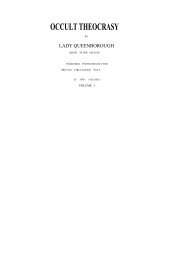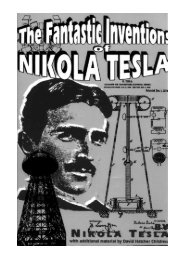the fantastic inventions of nikola tesla - Exopolitics Hong Kong
the fantastic inventions of nikola tesla - Exopolitics Hong Kong
the fantastic inventions of nikola tesla - Exopolitics Hong Kong
Create successful ePaper yourself
Turn your PDF publications into a flip-book with our unique Google optimized e-Paper software.
more heated than o<strong>the</strong>r points, and <strong>the</strong> result is that finally practically all <strong>the</strong> discharge passes through that point<br />
which is intensely heated, and a white stream <strong>of</strong> lime particles (Fig. 31) <strong>the</strong>n breaks forth from that point. This<br />
stream is composed <strong>of</strong> "radiant" matter, yet <strong>the</strong> degree <strong>of</strong> exhaustion is low. But <strong>the</strong> particles move in straight lines<br />
because <strong>the</strong> velocity imparted to <strong>the</strong>m is great, and this is due to three causes—to <strong>the</strong> great electric density, <strong>the</strong> high<br />
temperature <strong>of</strong> <strong>the</strong> small point, and <strong>the</strong> fact that <strong>the</strong> particles <strong>of</strong> <strong>the</strong> lime are easily torn and thrown <strong>of</strong>f—far more<br />
easily than those <strong>of</strong> carbon. With frequencies such as we are able to obtain, <strong>the</strong> particles are bodily thrown <strong>of</strong>f and<br />
projected to a considerable distance; but with sufficiently high frequencies no such thing would occur: in such case<br />
only a stress would spread or a vibration would be propagated through <strong>the</strong> bulb. It would be out <strong>of</strong> <strong>the</strong> question to<br />
reach any such frequency on <strong>the</strong> assumption that <strong>the</strong> atoms move with <strong>the</strong> speed <strong>of</strong> light; but I believe that such a<br />
thing is impossible; for this an enormous potential would be required. With potentials which we are able to obtain,<br />
even with a disruptive discharge coil, <strong>the</strong> speed must be quite insignificant.<br />
As to <strong>the</strong> "non-striking vacuum," <strong>the</strong> point to be noted is that it can occur only with low frequency impulses, and it<br />
is necessitated by <strong>the</strong> impossibility <strong>of</strong> carrying <strong>of</strong>f enough energy with such impulses in high vacuum since <strong>the</strong> few<br />
atoms which are around <strong>the</strong> terminal upon coming in contact with <strong>the</strong> same are repelled and kept at a distance for a<br />
comparatively long period <strong>of</strong> time, and not enough work can be performed to render <strong>the</strong> effect perceptible to <strong>the</strong><br />
eye. If <strong>the</strong> difference <strong>of</strong> potential between <strong>the</strong> terminals is raised, <strong>the</strong> dielectric breaks down. But with very high<br />
frequency impulses <strong>the</strong>re is no necessity for such breaking down, since any amount <strong>of</strong> work can be performed by<br />
continually agitating <strong>the</strong> atoms in <strong>the</strong> exhausted vessel, provided <strong>the</strong> frequency is high enough. It is easy to reach—<br />
even with frequencies obtained from an alternator as here used— a stage at which <strong>the</strong> discharge does not pass<br />
between two electrodes in a narrow tube, each <strong>of</strong> <strong>the</strong>se being connected to one <strong>of</strong> <strong>the</strong> terminals <strong>of</strong> <strong>the</strong> coil, but it is<br />
difficult to reach a point at which a luminous discharge would not occur around each electrode.<br />
A thought which naturally presents itself in connection with high frequency currents, is to make use <strong>of</strong> <strong>the</strong>ir powerful<br />
electro-dynamic inductive action to produce light effects in a sealed glass globe. The leading-in wire is one <strong>of</strong><br />
<strong>the</strong> defects <strong>of</strong> <strong>the</strong> present incandescent lamp, and if DO o<strong>the</strong>r improvement were made, that imperfection at least<br />
should be done away with. Following this thought, I have carried on experiments in various directions, <strong>of</strong> which<br />
some were indicated in my former paper. I may here mention one or two more lines <strong>of</strong> experiment which have been<br />
followed up. Many bulbs were constructed as shown in Fig. 32 and Fig. 33.<br />
Fig 32 – ELECTRO DYNAMIC<br />
INDUCTION COIL<br />
Fig 33. – ELECTRO DYNAMIC<br />
INDUCTION LAMP









